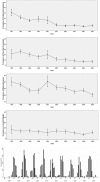Decreasing burden of malaria in pregnancy in Malawian women and its relationship to use of intermittent preventive therapy or bed nets
- PMID: 20700457
- PMCID: PMC2917365
- DOI: 10.1371/journal.pone.0012012
Decreasing burden of malaria in pregnancy in Malawian women and its relationship to use of intermittent preventive therapy or bed nets
Abstract
Background: The World Health Organization recommends insecticidal bednets and intermittent preventive treatment to reduce malaria in pregnancy. Longitudinal data of malaria prevalence and pregnancy outcomes are valuable in gauging the impact of these antimalarial interventions.
Methodology/principal findings: We recruited 8,131 women delivering in a single Malawian hospital over 9 years. We recorded demographic data, antenatal prescription of intermittent preventive therapy during pregnancy with sulfadoxine-pyrimethamine and bed net use, and examined finger-prick blood for malaria parasites and hemoglobin concentration. In 4,712 women, we examined placental blood for malaria parasites and recorded the infant's birth weight. Peripheral and placental parasitemia prevalence declined from 23.5% to 5.0% and from 25.2% to 6.8% respectively. Smaller declines in prevalence of low birth weight and anemia were observed. Coverage of intermittent preventive treatment and bednets increased. Number of sulfadoxine-pyrimethamine doses received correlated inversely with placental parasitemia (Odds Ratio (95% CI): 0.79 (0.68, 0.91)), maternal anemia (0.81, (0.73, 0.90)) and low birth weight from 1997-2001 (0.63 (0.53, 0.75)), but not from 2002-2006. Bednet use protected from peripheral parasitemia (0.47, (0.37, 0.60)) and placental parasitemia (0.41, (0.31, 0.54)) and low birth weight (0.75 (0.59, 0.95)) but not anemia throughout the study. Compared to women without nets who did not receive 2-dose sulfadoxine-pyrimethamine, women using nets and receiving 2-dose sulfadoxine-pyrimethamine were less likely to have parasitemia or low birth weight babies. Women receiving 2-dose sulfadoxine-pyrimethamine alone had little evidence of protection whereas bednets alone gave intermediate protection.
Conclusions/significance: Increased bednet coverage explains changes in parasitemia and birth weight among pregnant women better than sulfadoxine-pyrimethamine use. High bed net coverage, and sulfadoxine-pyrimethamine resistance, may be contributing to its apparent loss of effectiveness.
Conflict of interest statement
Figures



Similar articles
-
Intermittent preventive therapy with sulfadoxine-pyrimethamine for malaria in pregnancy: a cross-sectional study from Tororo, Uganda.PLoS One. 2013 Sep 4;8(9):e73073. doi: 10.1371/journal.pone.0073073. eCollection 2013. PLoS One. 2013. PMID: 24023811 Free PMC article.
-
An evaluation of the effects of intermittent sulfadoxine-pyrimethamine treatment in pregnancy on parasite clearance and risk of low birthweight in rural Malawi.Ann Trop Med Parasitol. 1998 Mar;92(2):141-50. doi: 10.1080/00034989859979. Ann Trop Med Parasitol. 1998. PMID: 9625909
-
Coverage of intermittent prevention treatment with sulphadoxine-pyrimethamine among pregnant women and congenital malaria in Côte d'Ivoire.Malar J. 2011 Apr 29;10:105. doi: 10.1186/1475-2875-10-105. Malar J. 2011. PMID: 21529344 Free PMC article.
-
Coverage of intermittent preventive treatment and insecticide-treated nets for the control of malaria during pregnancy in sub-Saharan Africa: a synthesis and meta-analysis of national survey data, 2009-11.Lancet Infect Dis. 2013 Dec;13(12):1029-42. doi: 10.1016/S1473-3099(13)70199-3. Epub 2013 Sep 18. Lancet Infect Dis. 2013. PMID: 24054085 Review.
-
Safety and toxicity of sulfadoxine/pyrimethamine: implications for malaria prevention in pregnancy using intermittent preventive treatment.Drug Saf. 2007;30(6):481-501. doi: 10.2165/00002018-200730060-00003. Drug Saf. 2007. PMID: 17536875 Review.
Cited by
-
Uptake of intermittent preventive treatment for malaria during pregnancy with Sulphadoxine-Pyrimethamine in Malawi after adoption of updated World Health Organization policy: an analysis of demographic and health survey 2015-2016.BMC Public Health. 2020 Mar 16;20(1):335. doi: 10.1186/s12889-020-08471-5. BMC Public Health. 2020. PMID: 32178658 Free PMC article.
-
The 'hidden' burden of malaria: cognitive impairment following infection.Malar J. 2010 Dec 20;9:366. doi: 10.1186/1475-2875-9-366. Malar J. 2010. PMID: 21171998 Free PMC article. Review.
-
Defending the Use of Sulfadoxine-Pyrimethamine for Intermittent Preventive Treatment for Malaria in Pregnancy: A Short-Sighted Strategy.J Infect Dis. 2016 Feb 1;213(3):496-7. doi: 10.1093/infdis/jiv420. Epub 2015 Aug 19. J Infect Dis. 2016. PMID: 26290607 Free PMC article. No abstract available.
-
Do multiple concurrent infections in African children cause irreversible immunological damage?Immunology. 2012 Feb;135(2):125-32. doi: 10.1111/j.1365-2567.2011.03523.x. Immunology. 2012. PMID: 22044389 Free PMC article. Review.
-
Adaptive evolution and fixation of drug-resistant Plasmodium falciparum genotypes in pregnancy-associated malaria: 9-year results from the QuEERPAM study.Infect Genet Evol. 2012 Mar;12(2):282-90. doi: 10.1016/j.meegid.2011.11.006. Epub 2011 Nov 20. Infect Genet Evol. 2012. PMID: 22119749 Free PMC article.
References
-
- Taha Tel T, Gray RH, Mohamedani AA. Malaria and low birth weight in central Sudan. Am J Epidemiol. 1993;138:318–325. - PubMed
-
- Rogerson SJ, van den Broek NR, Chaluluka E, Qongwane C, Mhango CG, et al. Malaria and anemia in antenatal women in Blantyre, Malawi: a twelve-month survey. Am J Trop Med Hyg. 2000;62:335–340. - PubMed
-
- Luxemburger C, McGready R, Kham A, Morison L, Cho T, et al. Effects of malaria during pregnancy on infant mortality in an area of low malaria transmission. Am J Epidemiol. 2001;154:459–465. - PubMed
-
- Desai M, ter Kuile FO, Nosten F, McGready R, Asamoa K, et al. Epidemiology and burden of malaria in pregnancy. Lancet Infect Dis. 2007;7:93–104. - PubMed
Publication types
MeSH terms
Substances
Grants and funding
LinkOut - more resources
Full Text Sources
Medical

